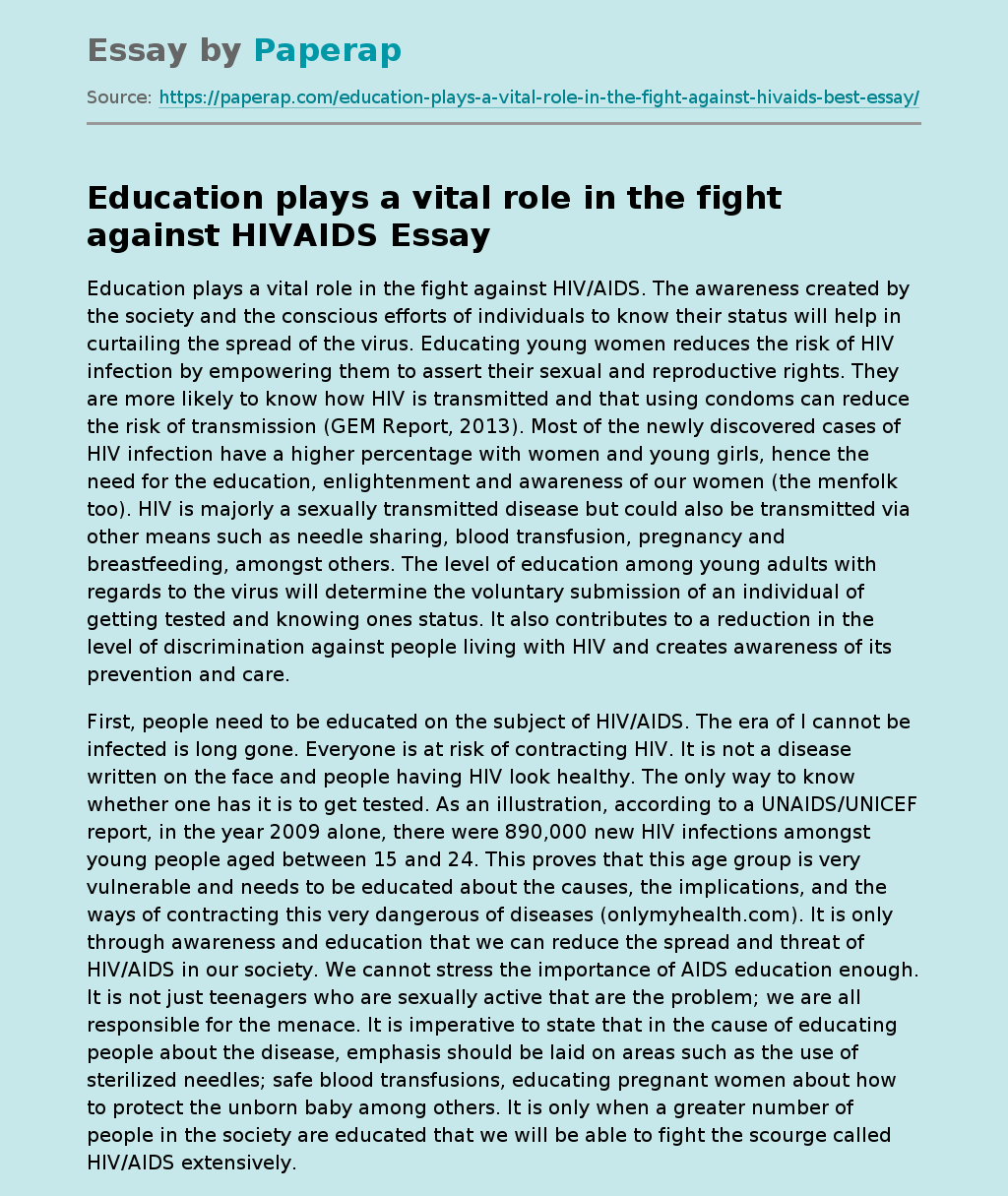The Fight Against HIV/Aids
The following example essay on “The Fight Against HIV/Aids” talks about HIV/AIDS and how education plays a vital role in the fight against HIV/AIDS.
The awareness created by the society and the conscious efforts of individuals to know their status will help in curtailing the spread of the virus. Educating young women reduces the risk of HIV infection by empowering them to assert their sexual and reproductive rights. They are more likely to know how HIV is transmitted and that using condoms can reduce the risk of transmission (GEM Report, 2013).
Most of the newly discovered cases of HIV infection have a higher percentage with women and young girls, hence the need for the education, enlightenment and awareness of our women (the menfolk too). HIV is majorly a sexually transmitted disease but could also be transmitted via other means such as needle sharing, blood transfusion, pregnancy and breastfeeding, amongst others. The level of education among young adults with regards to the virus will determine the voluntary submission of an individual of getting tested and knowing ones status.
It also contributes to a reduction in the level of discrimination against people living with HIV and creates awareness of its prevention and care.
First, people need to be educated on the subject of HIV/AIDS. The era of I cannot be infected is long gone. Everyone is at risk of contracting HIV. It is not a disease written on the face and people having HIV look healthy. The only way to know whether one has it is to get tested.
As an illustration, according to a UNAIDS/UNICEF report, in the year 2009 alone, there were 890,000 new HIV infections amongst young people aged between 15 and 24. This proves that this age group is very vulnerable and needs to be educated about the causes, the implications, and the ways of contracting this very dangerous of diseases (onlymyhealth.com).
It is only through awareness and education that we can reduce the spread and threat of HIV/AIDS in our society. We cannot stress the importance of AIDS education enough. It is not just teenagers who are sexually active that are the problem; we are all responsible for the menace. It is imperative to state that in the cause of educating people about the disease, emphasis should be laid on areas such as the use of sterilized needles; safe blood transfusions, educating pregnant women about how to protect the unborn baby among others. It is only when a greater number of people in the society are educated that we will be able to fight the scourge called HIV/AIDS extensively.
More importantly, it should be noted here that about 80% of infected people do not know how and where they got the virus and it would only be fair if the society does not isolate them. Many think of HIV as a disease that only certain groups get. This leads to negative value judgments about people who are living with HIV. Education also reduces the discrimination against HIV-positive children and adolescents that can lead them to drop out of school (GEM Report, 2013).
Stigmatization is a major challenge which if not addressed can lead to feelings of shame, fears of disclosure, isolation, and despair. For instance, people living with this virus including their immediate families and their service providers often receive negative treatment from people around them and this is why people infected prefer to keep to themselves in isolation. In some cases, their children are being treated as outcasts just because the parents are infected. These feelings can keep people from getting tested and treated for HIV, but with proper education, counseling and care, people would be better informed. One major differentiation that needed to be spelt out today is the difference between HIV and AIDS.
It is important to know that the ignorance that people carry is what has led to the spread of HIV/AIDS within our society. HIV and AIDS are related but are not the same. While HIV is but only a virus, it leads to AIDS once the virus has infected the body for some years and has destabilized the resistant system. It is for this simple reason that any HIV patient is encouraged to begin treatment with antiretroviral drugs.
Above all, the awareness on AIDS Education is very important today. In the years gone past, the HIV prevention attempts have greatly expanded. This positive news is as a result of the effective approaches discovered that helped prevent the transmission of HIV. However, to make the most of the impact on the HIV epidemic, awareness must be effectively increased. It should be incorporated into the high schools, colleges and universities syllabus, as it has been established that the age group with the highest risk is between 15 and 24. The most potent form of prevention is awareness.
Other prevention methods may include the right use of condoms; avoid sharing needles, sharp objects, mother-child transmission and proper screening of blood for transfusion. Young people should be educated and encouraged that abstinence remains the best preventive method. Moreover, studies have shown that the correct use of anti-retroviral drugs which results in having an undetectable viral load also prevents transmission. One may also be able to take advantage of newer HIV prevention medicines such as pre-exposure prophylaxis (PrEP) and post-exposure prophylaxis (PEP).
There is the need for comprehensive support from other government and Non Governmental Organizations to come to the aid of People Living with HIV to control its spread while research works continue to find a final cure for the disease.
The Fight Against HIV/Aids. (2019, Dec 01). Retrieved from https://paperap.com/education-plays-a-vital-role-in-the-fight-against-hivaids-best-essay/

